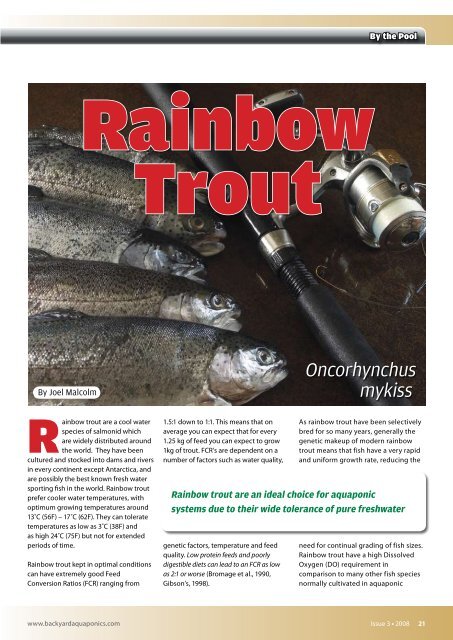Keeping Trout - Backyard Magazines
Keeping Trout - Backyard Magazines
Keeping Trout - Backyard Magazines
You also want an ePaper? Increase the reach of your titles
YUMPU automatically turns print PDFs into web optimized ePapers that Google loves.
By Joel Malcolm<br />
www.backyardaquaponics.com<br />
Rainbow<br />
<strong>Trout</strong><br />
Rainbow trout are a cool water<br />
species of salmonid which<br />
are widely distributed around<br />
the world. They have been<br />
cultured and stocked into dams and rivers<br />
in every continent except Antarctica, and<br />
are possibly the best known fresh water<br />
sporting fish in the world. Rainbow trout<br />
prefer cooler water temperatures, with<br />
optimum growing temperatures around<br />
13˚C (56F) – 17˚C (62F). They can tolerate<br />
temperatures as low as 3˚C (38F) and<br />
as high 24˚C (75F) but not for extended<br />
periods of time.<br />
Rainbow trout kept in optimal conditions<br />
can have extremely good Feed<br />
Conversion Ratios (FCR) ranging from<br />
1.5:1 down to 1:1. This means that on<br />
average you can expect that for every<br />
1.25 kg of feed you can expect to grow<br />
1kg of trout. FCR’s are dependent on a<br />
number of factors such as water quality,<br />
genetic factors, temperature and feed<br />
quality. Low protein feeds and poorly<br />
digestible diets can lead to an FCR as low<br />
as 2:1 or worse (Bromage et al., 1990,<br />
Gibson’s, 1998).<br />
By the Pool<br />
Oncorhynchus<br />
mykiss<br />
As rainbow trout have been selectively<br />
bred for so many years, generally the<br />
genetic makeup of modern rainbow<br />
trout means that fish have a very rapid<br />
and uniform growth rate, reducing the<br />
Rainbow trout are an ideal choice for aquaponic<br />
systems due to their wide tolerance of pure freshwater<br />
need for continual grading of fish sizes.<br />
Rainbow trout have a high Dissolved<br />
Oxygen (DO) requirement in<br />
comparison to many other fish species<br />
normally cultivated in aquaponic<br />
Issue 3 • 2008 21


